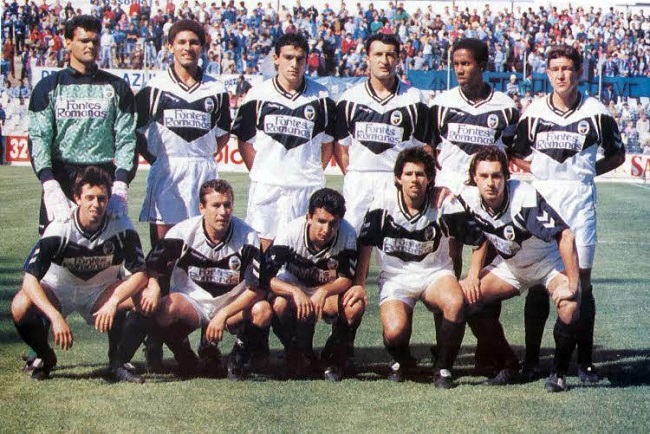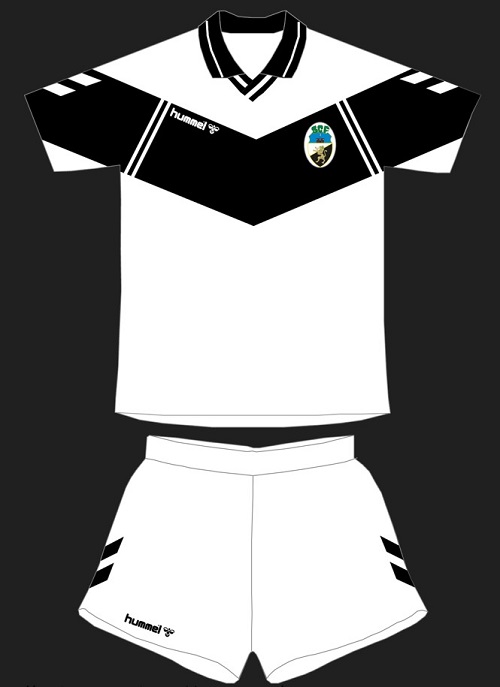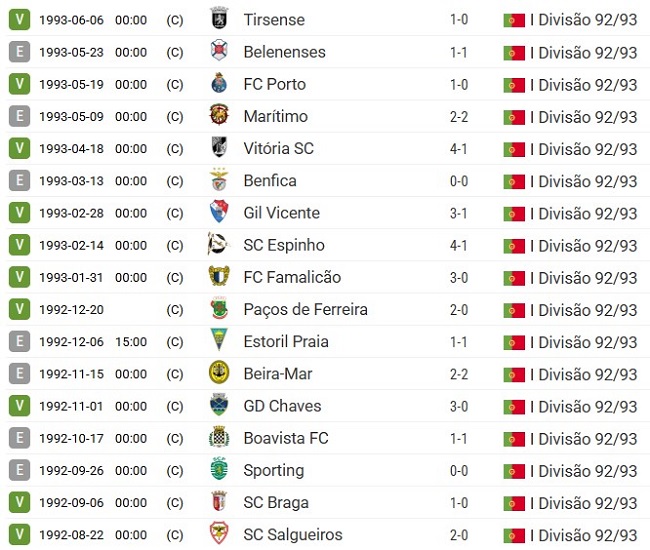Football in the Algarve was always a big thing, but not until the 1990s did it truly feel like it. Although Olhanense famously won a Campeonato de Portugal edition way back in the 1920s – one of the biggest and most surprising feats in Portuguese football history – and Portimonense stood up pretty well during the 1980s in the top tier, it wasn’t until Farense rose to prominence in the following decade that things started to light up.
The 1990 Cup final was only the first step for the Faro Lions. During the 1990s, Farense became one of the biggest fan-favourites in the league, well-supported all around the land due to their strong identity, the passion felt at each home game in the São Luís stadium and the cheerful character of their Catalan manager, Paco Fortes. Come 1992, they also sported one of the most iconic kits in the league, a shirt worthy of their impact in a new era where football became more decentralised, with Madeira, the Minho region and the Algarve enjoying an enduring relevance they had never had before.
***

Golden nineties
Farense finished the 1991/92 season sixth, six points behind Vitória SC, who qualified for Europe. The previous season, they ended two points behind Salgueiros, who also booked a ticket for the UEFA Cup. Something was brewing at the Algarve, and many dreamt that a time would come when they would finally get the chance they deserved to play continental football.
The core of the side didn’t change, nor did the most important element of the project. Paco Fortes remained on the bench, and alongside him were the likes of Hugo, Jorge Soares, Portela, Ademar, Hajry, Sérgio Duarte, Miguel Serodio and Djukic, who were now joined by Hassan Nader, signed from Mallorca.
The club had left Adidas to join with the German company Hummel for the 1992/93 season, and the brand, which was already famous for its radical and innovative templates, came up with one of the most iconic shirts the club ever wore. A huge inverted black triangle covered the chest of a mainly white kit and shirts, with black socks to go along with it. The neck was also black, as was part of the shoulders, with the sponsorship of Fontes Romanas printed in blue and white inside the triangle. The club crest was sewn in a circular fashion above the sponsorship and alongside the sports brand logo.
The alternative kit didn’t follow a similar pattern as was customary. The club sported a green-only shirt, with the same sponsor in white, and white shorts and socks. There was no third kit available for the season, although in some matches Farense did play without a main sponsor, sporting just the black inverted triangle alongside the all-white shirt.

The club wore their main kit in thirty of the matches played during the season, although they often changed the main white shorts for black ones. Against Vitória SC and Boavista away, they went with the green and white version instead and lost both matches. At home, against the Guimarães side, they played in all green against the all-white of the visitors (whose home and away kit clashed with Farense’s), and on that occasion they came out as winners after a 4-1 thrashing. Curiously, the goalkeeper kit followed the same pattern used by Peter Schmeichel with the Danish side that won the Euro 92, a colourful, iconic template.
Fortress São Luís
The season was remarkable not only because the club finished again sixth, something nobody expected, even if they once again fell short of a continental ticket. This time, only two points separated Paco Fortes’ men from Marítimo, but nonetheless, the crowd of the São Luís enjoyed a season like no other. While they only won one match away from home, against Braga, at the São Luís they remained unbeaten for the entire season, a series that was stretched for half of the 1993/94 season as well.
Not one of the Big Three won there, with Benfica and Sporting held to goalless draws and future league champions FC Porto beaten by a single Hugo goal, a brilliant header following a Djukic cross that left Vitor Baía hapless. The match was played in mid-May and was extremely tense with several fouls bordering on violence, with staff members of each club almost coming to blows at half time. It was actually a fixture that should have been played in week 26 but had been postponed. The unexpected win put Farense right into contention for that final European spot, but a defeat in the penultimate day of the season at Paços de Ferreira cut short their dreams.

The Algarve outfit had to wait two more seasons, but in 1994/95 Farense finally finished fifth, their best result to this day, one point ahead of União de Leiria to book a place in the UEFA Cup. And they put up a good fight in European play, although they would be beaten by Olympique Lyon by a mere single goal in each match of the first round. By then, the club had dropped Hummel, first for the British Reebok brand, copying the same template that would be famous in the mid-1990s, with the logo on the right shoulder in black, and then moving to Saillev, a popular brand in the mid-nineties Portuguese football, who opted for a singular black strip. On both occasions, Pingo Doce was now the main sponsor and would remain so until the end of the decade.
Twenty-year absence
With coach Paco Fortes now departed, Farense started to lose part of their identity, especially playing at home, and were finally relegated in 2002 and four years later had dropped to the regional leagues after being declared bankrupt.
Football in the Algarve went missing from the first tier for almost a decade before Olhanense, briefly, and then Portimonense, returned the region’s lost pride. In 2022, Farense finally got promoted again and has since been an up-and-down club. The memories of the golden nineties are not forgotten though, and despite that memorable Cup run in 1990 and the fantastic European qualifying achievement in 1994, if there’s a shirt people think about when they think about the Faro Lions, it remains that iconic Hummel template that put the São Luís on the list of Portugal’s most iconic football grounds.

